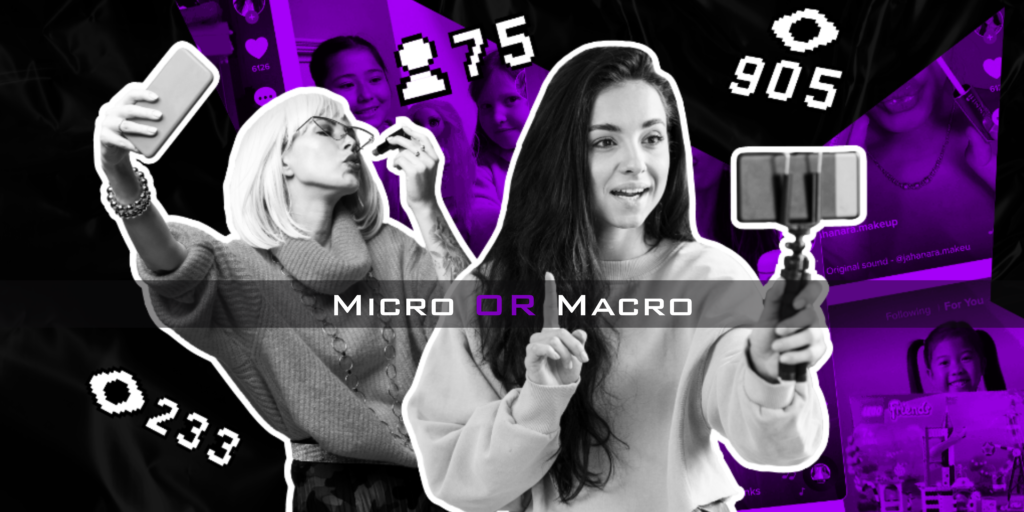In the ever-evolving landscape of influencer marketing, brands are faced with a critical decision: should they collaborate with micro-influencers or macro-influencers? Both categories offer unique advantages and cater to different audience segments, making it essential for brands to understand the nuances of each approach. In this blog post, we’ll explore the differences between micro-influencers and macro-influencers and help you determine which strategy aligns best with your brand’s goals and objectives.
Introduction:
Influencer marketing has become a cornerstone of modern-day brand promotion, offering unparalleled access to engaged audiences across various social media platforms. As brands seek to leverage the power of influencers to drive awareness, engagement, and sales, the debate between micro-influencers and macro-influencers continues to intensify. Let’s delve into the characteristics, benefits, and considerations associated with each influencer category.
MICRO-INFLUENCERS:
Micro-influencers are individuals with a modest but dedicated following on social media, typically ranging from a few thousand to tens of thousands of followers. Despite their smaller reach compared to macro-influencers, micro-influencers boast higher engagement rates and often possess niche expertise in specific topics or industries. By collaborating with micro-influencers, brands can tap into highly targeted audiences and benefit from authentic, relatable content that resonates with consumers on a personal level.
Key Benefits of Micro-Influencers:
Authenticity: Micro-influencers are perceived as more authentic and trustworthy by their followers, fostering genuine connections and brand advocacy.
Niche Audience: Micro-influencers cater to niche communities, allowing brands to reach highly relevant and engaged audiences interested in specific topics or products.
Cost-Effectiveness: Collaborating with micro-influencers is often more budget-friendly than partnering with macro-influencers, making it an attractive option for brands with limited resources.
High Engagement: Micro-influencers typically enjoy higher engagement rates compared to macro-influencers, driving meaningful interactions and conversions for brands.
Considerations for Micro-Influencers:
Scale: While micro-influencers offer targeted reach, brands may need to collaborate with multiple influencers to achieve broader exposure.
Content Quality: Brands should assess the quality and consistency of content produced by micro-influencers to ensure alignment with brand standards and messaging.
Relationship Management: Building and nurturing relationships with a network of micro-influencers requires time and effort to maximize the effectiveness of campaigns.
MACRO-INFLUENCERS:
Macro-influencers, on the other hand, are social media personalities with large followings exceeding hundreds of thousands or even millions of followers. These influencers wield significant influence and have the potential to reach massive audiences across various demographics. While macro-influencers offer unparalleled reach and visibility, their audiences may be less niche-specific, resulting in lower engagement rates compared to micro-influencers.
Key Benefits of Macro-Influencers:
Wide Reach: Macro-influencers have the ability to reach vast audiences spanning different demographics and geographic locations, offering brands extensive exposure.
Brand Awareness: Collaborating with macro-influencers can significantly boost brand visibility and awareness, driving top-of-mind recall among consumers.
Credibility: Macro-influencers often enjoy celebrity status and perceived authority in their respective fields, lending credibility and prestige to brands associated with them.
Content Diversity: Macro-influencers possess the resources and creativity to produce diverse and high-quality content across various platforms, enriching brand storytelling and messaging.
Considerations for Macro-Influencers:
Cost: Partnering with macro-influencers typically involves higher costs and may require substantial budget allocation, especially for long-term collaborations or sponsored campaigns.
Engagement Rates: While macro-influencers offer broad reach, their engagement rates may vary, and audiences may exhibit lower levels of interaction compared to micro-influencers.
Audience Relevance: Brands should carefully evaluate the alignment between a macro-influencer’s audience demographics and their target market to ensure effective campaign performance.
Choosing the Right Strategy:
Ultimately, the decision to collaborate with micro-influencers or macro-influencers hinges on various factors, including budget, campaign objectives, target audience, and brand identity. By conducting thorough research, setting clear goals, and understanding the unique advantages of each influencer category, brands can devise a tailored influencer marketing strategy that maximizes ROI and achieves desired outcomes.
Conclusion:
In the dynamic realm of influencer marketing, brands must navigate the complexities of choosing between micro-influencers and macro-influencers to optimize their marketing efforts. Whether prioritizing niche engagement or broad brand visibility, selecting the right influencer strategy requires careful consideration of audience preferences, campaign goals, and budget constraints. By leveraging the strengths of both micro-influencers and macro-influencers, brands can forge meaningful connections, drive authentic engagement, and propel their businesses to new heights in the digital landscape.

